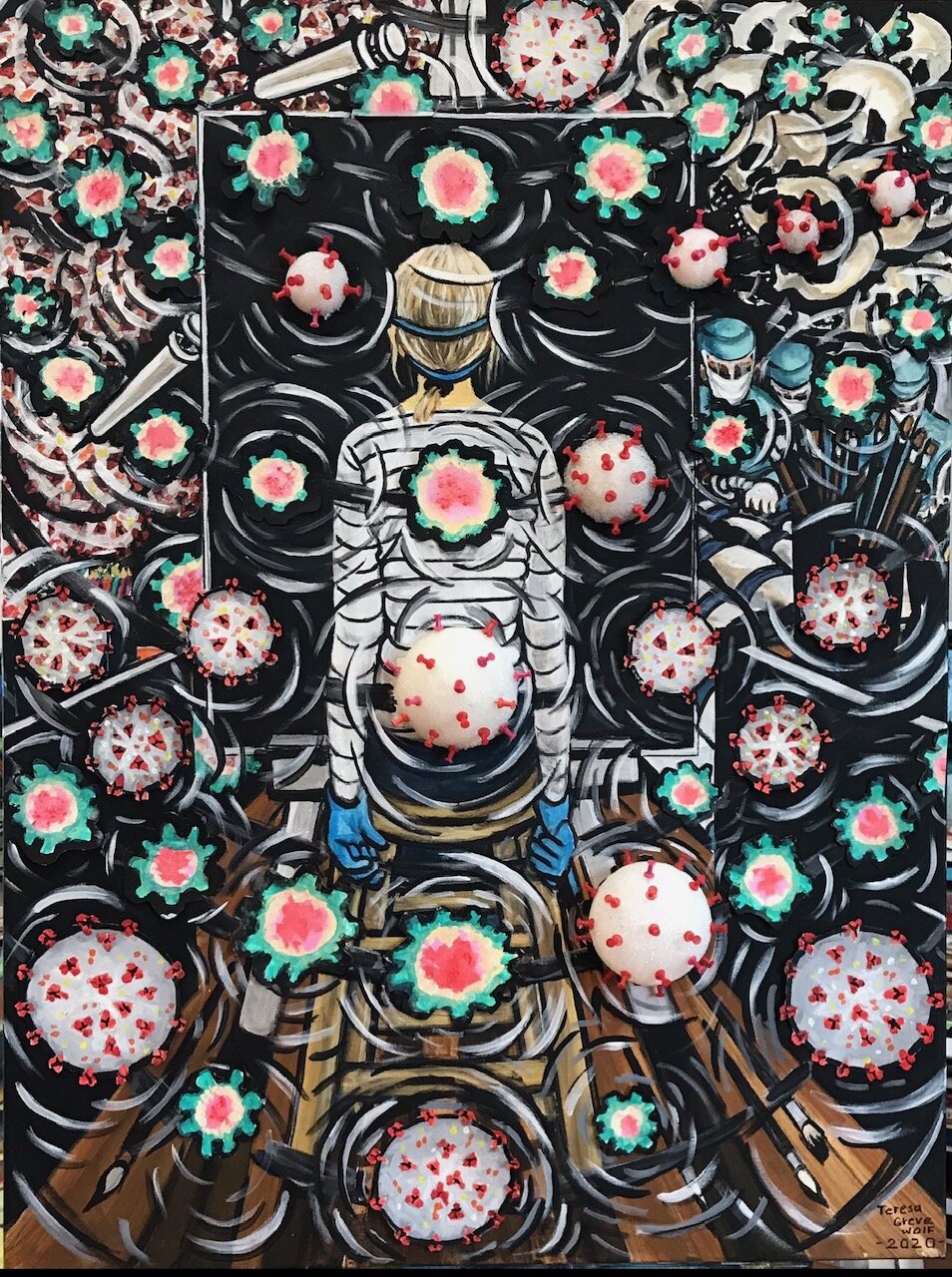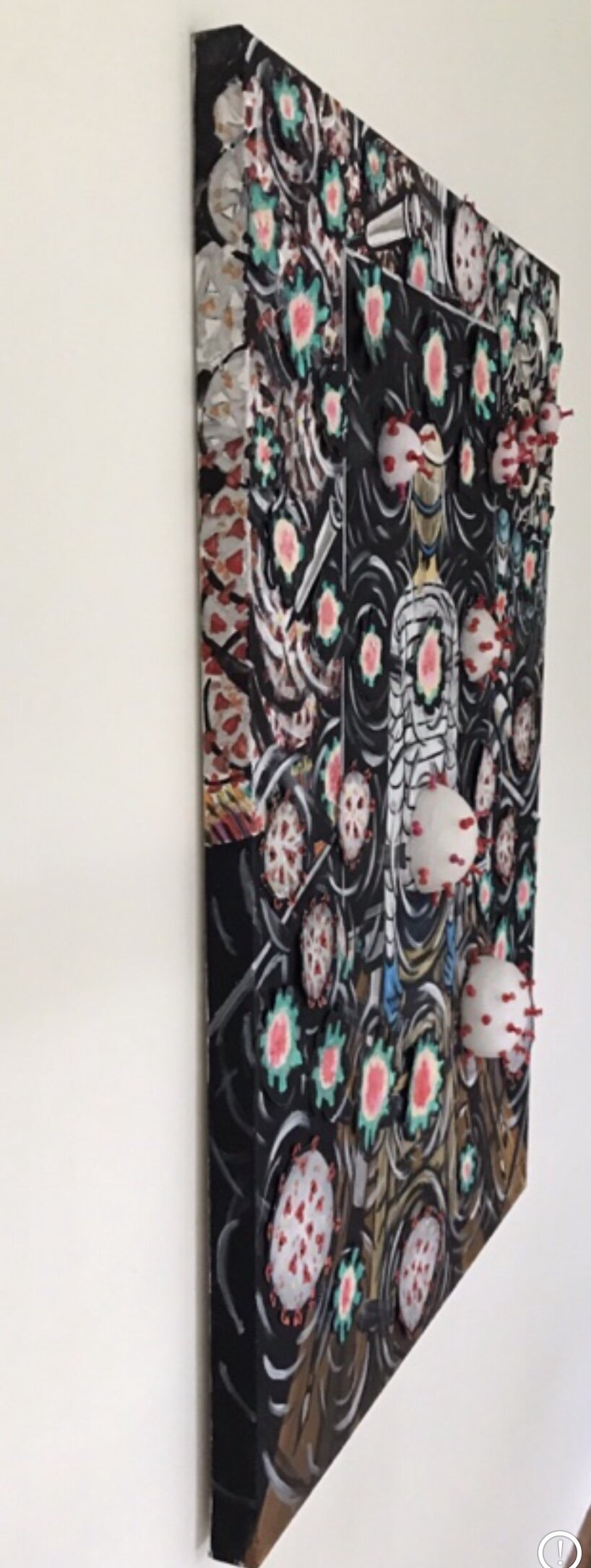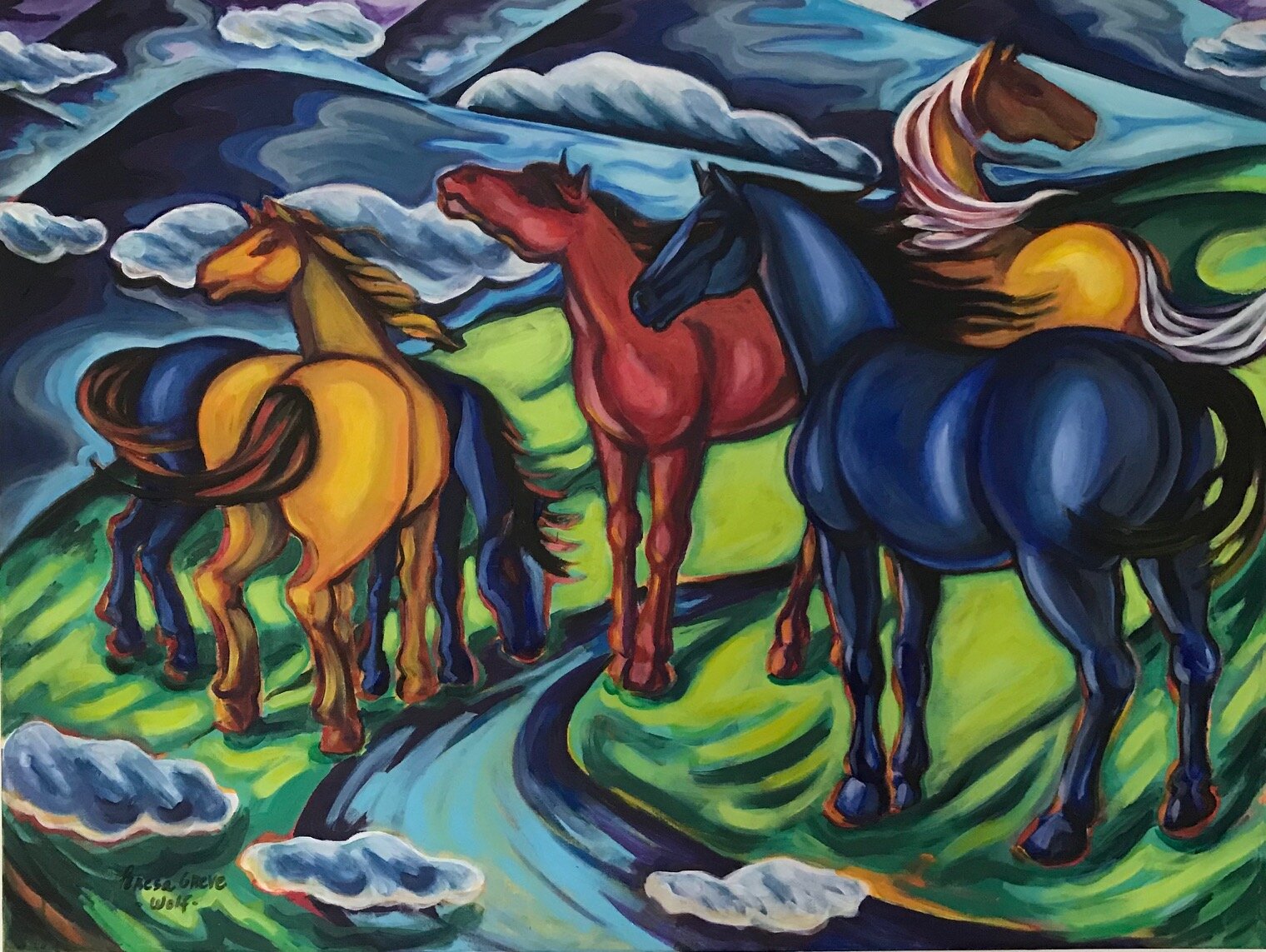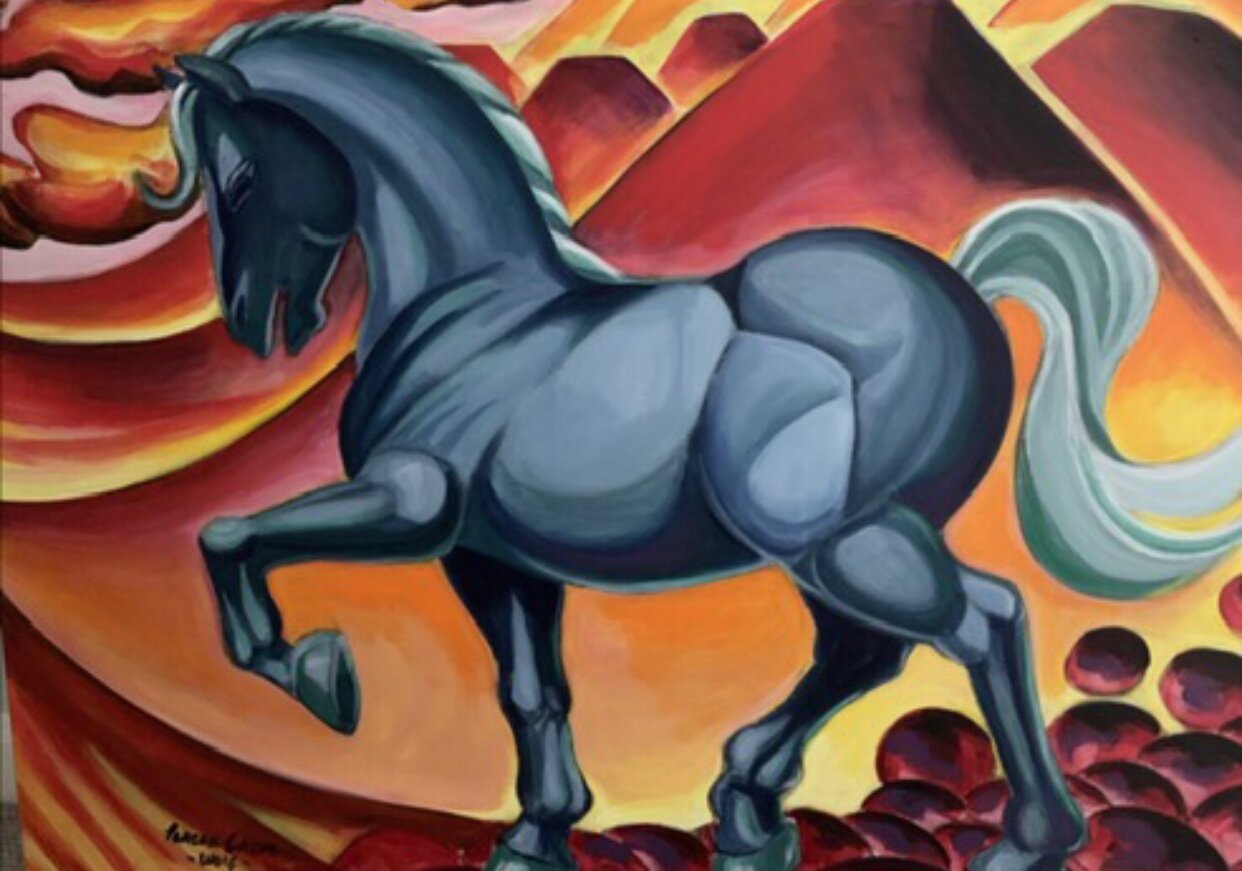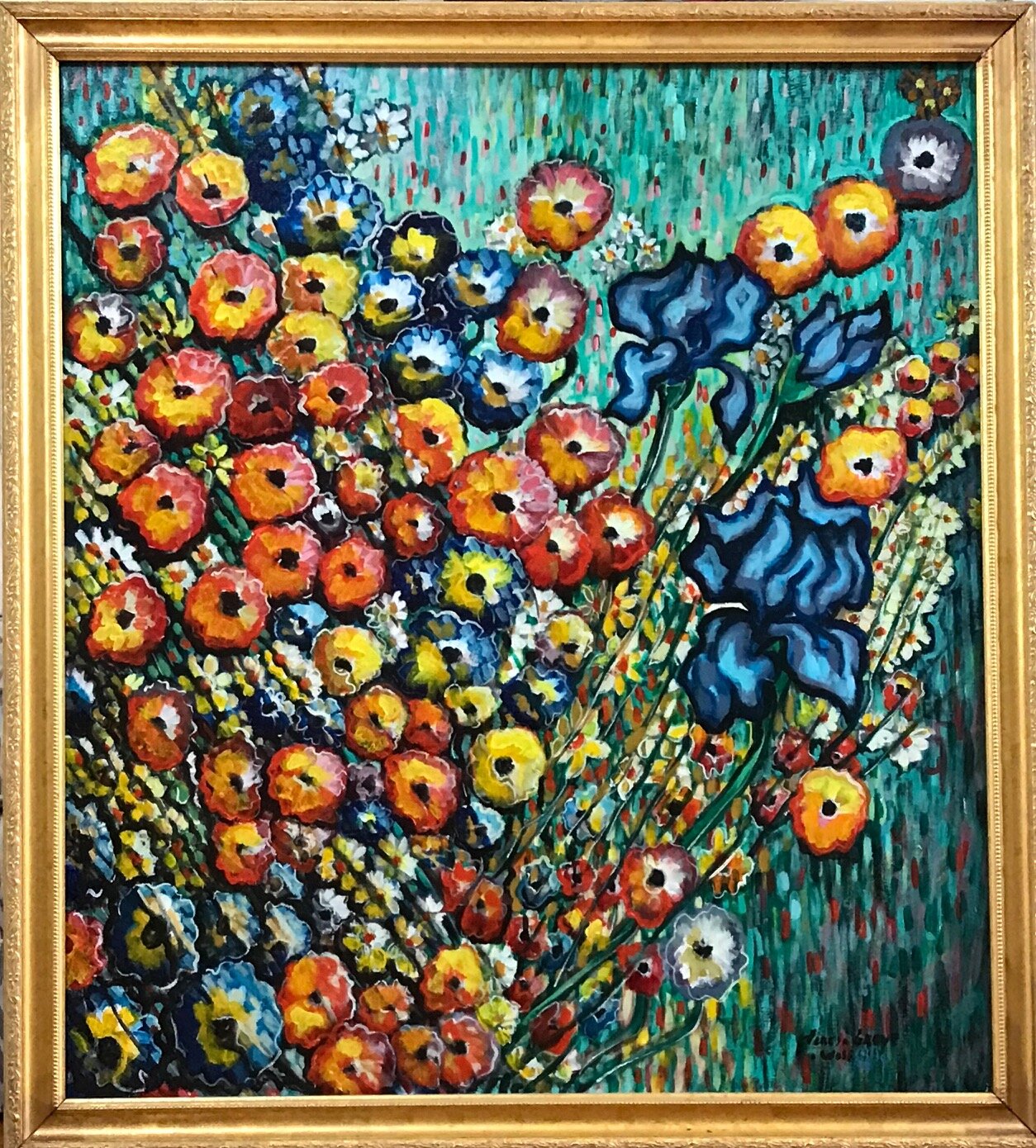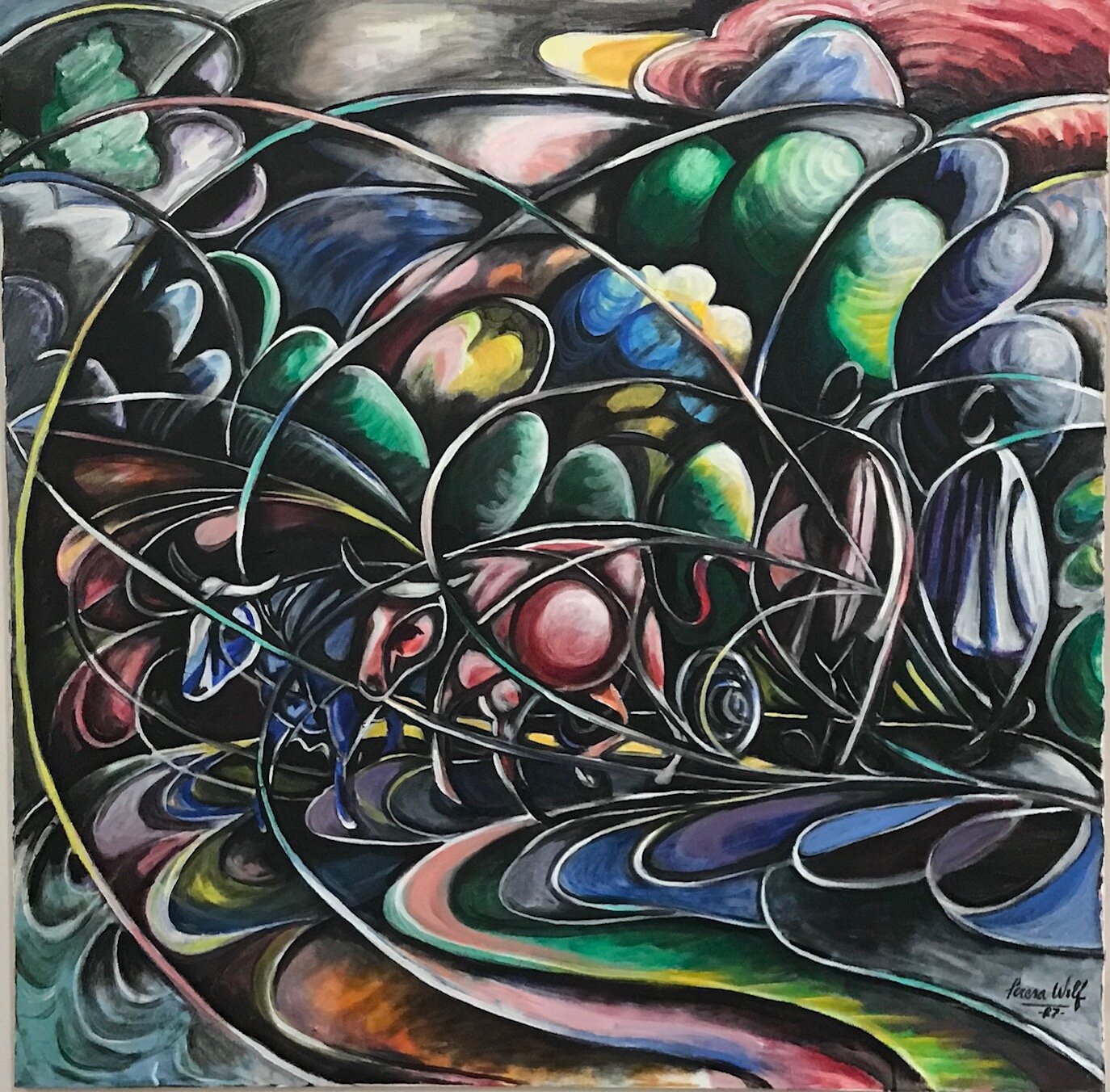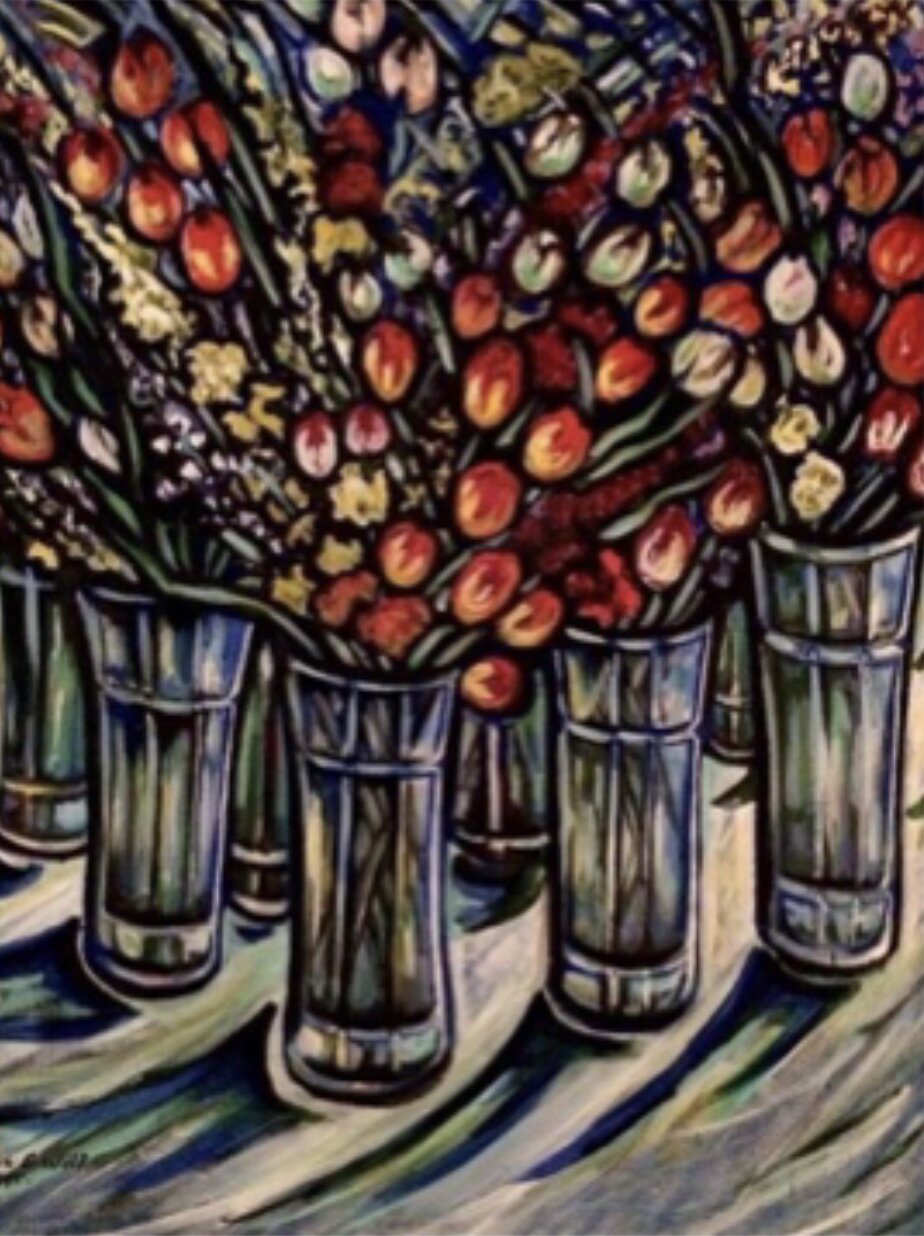Teresa Greve Wolf
I first encountered Teresa Greve Wolf’s art at the Colfax Cultural Center’s Art & Social Justice Exhibit in 2019. Some of Wolf’s work explores immigration and social justice. As an immigrant from Chile herself she feels a resonance with the experience and plights of current immigration. Wolf depicts the struggles and hardship of social issues in bold dramatic scenes. In her art you feel empathy for the plights of her storied representations. The power of larger forces of nature and society playing out in the background speak to the struggle of individuals overcoming overwhelming odds.
“Language was a major obstacle in my own personal experience, and once I gained a better knowledge of English, I felt okay. Over time, I learned to love this country as well, which is way I painted a canvas dedicated to an image of myself wrapped in two flags– that of Chile and that of the United States. My reason for coming to the United States was that my husband came to study at the University of California at Berkeley to finish his doctor degree in Engineering. However, during this time, the dictator known as Pinochet grabbed power in Chile, and we decided to stay in the U.S. a few years longer, in the hopes that this cruel and corrupt figure would step down soon. Sadly, it took 16 years for this dictator to leave power. In the meantime, my husband took a job at the University of Notre Dame, and after several years, we had our four children and he became a Full Professor. By then, it was hard to go back to Chile, as our children had grown up here and my husband had become well known in his field. I myself had continued to pursue painting during this time and taught several generations of young artists in my own studio while developing my own painting style and a large body of work. I think of my spouse and I as having achieved an “American Dream”, but my definition of “American” includes both the heritages of South America (Chile) and North America (USA), which has made our lived experience across both continents so meaningful.” ”
The painting was created after visiting London. The painting represents the underground where people are focused on themselves going about their business. On the walls are the larger concerns and troubles of the world
“Best known for her use of bold color, and strong brush strokes, Teresa has evolved as an artist whose works demonstrate her mastery of the acrylic paint medium. Her landscapes dance, canvases of bright and bold flowers impress while majestic mountains intrigue, all whispering the influences of Cezanne, Kandinsky and Marc. Although her uplifting florals both please the eye and command a room, we see versatility throughout her collection. Several of her works, including multicolored fisherman's boats and Southern Chilean scenes pay homage to her native homeland, while other pieces break away from the serene. Dramatic statements on the struggles of modern immigration and her own experiences of a life up ended, reveal her capacity to express bold emotions.” From Wolf’s website.
Teresa Geve Wolf moved to America with her husband so he could study at Berkley. They were going to return to Chile, but Pinochet was in power for 17 years. They felt they did not want to live under a dictatorship. We decided my husband would apply for jobs in the United States. He landed a job at Notre Dame and Wolf has been here since. Wolf began taking classes at Notre Dame. She also studied under Harold Zisla and Anthony Droege at IUSB.
“My artwork insistently reflects my keen interest in bold colors, strong lines, and constantly challenging the creative process. In my paintings, I innovatively render and re-interpret diverse subject matter drawing upon a wide array of aesthetic approaches, mark-making techniques, and visual sources. A large portion of my artistic production involves crafting series of works that are focused on the same subject or variations of a theme. This approach allows me to revisit the selected place, person, object or idea at the epicenter of my inspiration in a mode that addresses my relationship to the subject in terms of temporality, emotion, and sensory experience. At the same time, each piece is infused with my personal interpretation and signature style, immersing the viewer in the rich palette of colors and daring brushstrokes that makes my work instantly recognizable. In this way, my artistic practice serves as a vibrant visual record, cognizant of the fact that even as one’s subjects shift and change, each artwork embodies the essence of interpretation and individual expression.” ”
Wolf’s grandfather immigrated from Germany to Chile in the 1800s as part of a land reform. Wolf inherits her artistic ability from her father who was a painter and cartoonist. Watching her father draw and paint influenced her calling to art. “It is in our DNA,” says Wolf, “My aunts were artists, my sisters are artists, my children are artists.”
“Viral Confusion is on exhibit at the Museo de las Americas in Denver Colorado. Wolf created this multi-media 3-D piece in response to the COVID-19 outbreak.
Viral Confusion, acrylic, water color, and Styrofoam.
“For me, and others affected by the crisis, the impact of coronavirus has been nightmarishly surreal. As societies globally transition to quarantine to “flatten the curve,” the virus stirs feelings of isolation and overwhelming confusion as to how to keep oneself and loved ones safe in pandemic times. As an artist I feel increased apprehension while mourning the loss of access to practices, materials, and networks I enjoyed in a covid-free world.
The experience of social-distancing has heightened the sense of living in an isolated bubble, just as the virus “bubbles up” around the nation. I find myself caught up in thoughts of the virus circulating in the atmosphere and capable of contaminating in the moment that one is off-guard. These intense anxieties alternatively block and inspire my creative production, challenging my skills and mind to confront the crisis and draw on the materials I have on hand around me.”
“While I was learning,” says Wolf, “I had four kids. I could not keep studying. I copied famous artists from Rembrandt to Van Gogh.” She says that one day she said to herself, I do not want to copy anymore. “Naturally, my style became what you see today,” says Wolf.
Wolf says you can learn by copying the works of the great artists. You learn how they solved problems in their art. You learn how they used the angle of light and how they used shadow and dark. Says Wolf, “Different artists have different solutions to a problem.”
“I often think about current issues of immigration, which, along with my own immigrant experience, has led to me to paint a series of artworks based on imagery of intertwined flags. These paintings aim to express a variety of feelings tied to the immigrant experience, such as the sensation that one does not know where they belong, the longing and love for one’s homeland, and the knowledge that no matter what or how one has arrived in their newly adopted country, they will receive different responses of reception from those who live there. Some will welcome you, while others will reject you, and one faces the challenge of learning to live under difficult circumstances. Teresa Greve Wolf”
“I am drawn to painting horses for many reasons, largely tied to the warm memories I have of these animals growing up in Chile. As a child raised in the country's capital of Santiago, I used to go to my grandfather’s farm in the countryside every summer with my family. Going to the farm was a truly enjoyable experience, because my sisters, brother, and cousins were all there. Additionally, there were also a variety of animals, including cows, pigs, chickens, and horses on the farm.
We spent a lot of time together around the horses, as they were everyone's favorites. Even when we did not ride them, we were always around them. We would walk to the stable, and to the fields where they grazed and relaxed. Sometimes we just walked to the old willow tree, where the horses were already hitched and saddled up, ready to take whoever who wanted to go out for a ride.
The horses were beautiful, they were strong, and well-kept. They were an array of different colors, some were vanilla colored, some brown, and some grey and white. They also each had their own unique names.
Because of the wonderful times we spent with these creatures, and because my dear Father –who was also an artist– used to often draw and paint them, these horses have been always in my mind. In my paintings, I choose to render these beautiful animals just the way I remember them in my memories of the farm – as strong and powerful, emblematic of my Chilean homeland.” Teresa Greve Wolf
“I miss the Andes Mountains. Sometimes I see the clouds here and they remind me of Chili. Then I
truly long for the mountains.” Says Wolf.
“I challenge myself to constantly be changing,” says Wolf. She says others have defined her as an expressionist, but she feels she pulls so many styles into her art it is unique to itself. She says, “Some people love to do landscapes or portraits and they do it all the time. I don’t like to do the same subject. I paint landscapes, flowers, portraits, abstracts. I do as much as I can take on.”
“I like to put some part of myself in the painting,” says Wolf. “I could do a very exact painting, but to me, that is not you. Why not take a photograph instead?”
Read more about Teresa Greve Wolf by reading the book her daughter wote at https://www.amazon.com/Teresa-Greve-Wolf-Christina/dp/1320796516
You can find more of Teresa Greve Wolf’s art and contact her through








